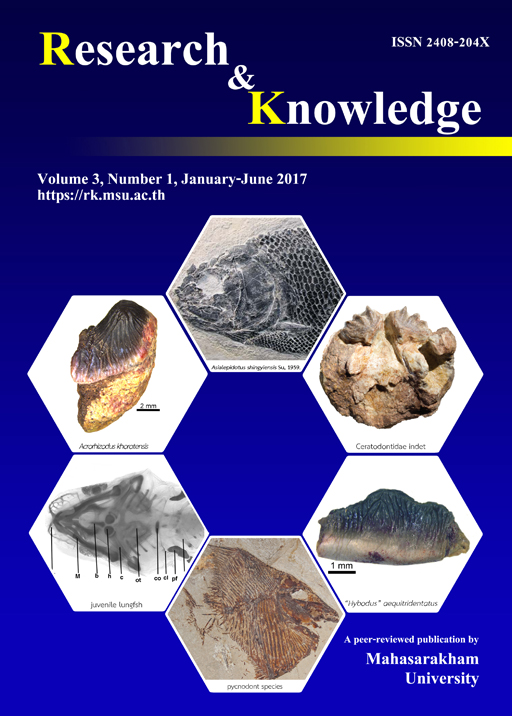New data on Cretaceous freshwater hybodont sharks from Guangxi Province, South China
Keywords:
Hybodont sharks, Cretaceous, Asia, freshwater, endemismAbstract
The Lower Cretaceous Xinlong Formation in Guangxi Zhuang Autonomous region, which was deposited in a non-marine, fluvial environment, has yielded a diverse assemblage of vertebrates. The study of the shark teeth from the Xinlong Formation revealed the presence of teeth of Acrorhizodus khoratensis that do not appear to correspond to a jaw position retrieved in Thailand. It also provides a new understanding of the systematic affinities of the species “Hybodus” aequitridentatus. The latter does not belong to te genus Hybodus but to a new genus belonging to the family Thaiodontidae. The material found in the Xinlong Formation also questions our understanding of the heterodonty pattern of the genus Acrorhizodus and highlights how peculiar this genus is among Hybodontiformes. As only two teeth differ significantly from the material retrieved in Thailand, it is difficult to assess whether the Chinese material includes a species different from the Thai one, but it certainly calls for a careful reappraisal of all the available material to better assess the heterodonty pattern of this genus.
References
Amiot, R., Buffetaut, E., Lécuyer, C., Fernandez, V., Fourel, F., Martineau, F. and Suteethorn, V. 2009. Oxygen isotope composition of continental vertebrate apatites from Mesozoic formations of Thailand; environmental and ecological significance. In: Buffetaut, E., Cuny, G., Le Loeuff, J. and Suteethorn, V. (Eds.), Late Paleozoic and Mesozoic Continental Ecosystems in SE Asia, Geological Society London Special Publications. The Geological Society, London, pp. 271–283.
Amiot, R., Wang, X., Zhou, Z., Wang, X., Buffetaut, E., Lécuyer, C., Ding, Z., Fluteau, F., Hibino, T., Kusuhashi, N., Mo, J., Suteethorn, V., Wang, Y., Xu, X. and Zhang, F. 2011. Oxygen isotopes of East Asian dinosaurs reveal exceptionally cold Early Cretaceous Climates. Proceedings of the National Academy of Sciences 108, 5179–5183.
Cappetta, H. 2012. Chondrichthyes. Mesozoic and Cenozoic Elasmobranchii: Teeth. Verlag Dr. Friedrich Pfeil, München, pp. 512.
Cappetta, H., Buffetaut, E., Cuny, G. and Suteethorn, V. 2006. A new elasmobranch assemblage from the Lower Cretaceous of Thailand. Palaeontology 49(3), 547-555.
Cuny, G. 2012. Freshwater hybodont sharks in Early Cretaceous ecosystems: A review. In: Godefroit, P. (Ed.), Bernissart Dinosaurs and Early Cretaceous Terrestrial Ecosystems. Indiania University Press, Bloomington, pp. 518-529.
Cuny, G., Liard, R., Deesri, U., Liard, T., Khamha, S. and Suteethorn, V. 2014. Shark faunas from the Late Jurassic-Early Cretaceous of northeastern Thailand. Paläontologische Zeitschrift 88, 309-328.
Cuny, G., Suteethorn, V., Buffetaut, E. and Philippe, M. 2003. Hybodont sharks from the Mesozoic Khorat Group of Thailand. Mahasarakham University Journal, 22, special issue, 49-68.
Cuny, G., Suteethorn, V., Kamha, S. and Buffetaut, E. 2008. Hybodont sharks from the Lower Cretaceous Khok Kruat Formation of Thailand, and hybodont diversity during the Early Cretaceous. In: Cavin, L., Longbottom, A. and Richter, M. (Eds.), Fishes and the Break-up of Pangaea. Geological Society, London, Special Publications, 295, 93-107.
Hay, O. P. 1902. Bibliography and catalogue of the fossil vertebrate of North America. Bulletin of the United States Geological Survey 179, 1-868.
Huxley, T. H. 1880. On the application of the Laws of Evolution to the Arrangement of the Vertebrata, and more particularly of the Mammalia. Proceedings of the Zoological Society, 1880, 649-662.
Maisch, M. W. and Matzke, A. T. 2016. A new hybodontid shark (Chondrichthyes, Hybodontiformes) from the Lower Jurassic Posidonienschiefer Formation of Dottrenhausen, SW Germany. Neues Jahrbuch für Geologie und Paläontologie Abhandlungen 280, 241-257.
Maisey, J. G. 1987. Cranial anatomy of the Lower Jurassic shark Hybodus reticulatus (Chondrichthyes: Elasmobranchii), with comments on hybodontid systematics. American Museum Novitates 2878, 1-39.
McAnena, A., Flögel, S., Hofmann, P., Herrle, J. O., Griesand, A., Pross, J., Talbot, H. M., Rethemeyer, J., Wallmann, K. and Wagner, T. 2013. Atlantic cooling associated with a marine biotic crisis during the mid-Cretaceous period. Nature Geoscience 6, 558–561.
Mo, J., Buffetaut, E., Tong, H., Amiot, R., Cavin, L., Cuny, G., Suteethorn, V., Suteethorn, S. and Jiang, S. 2016. Early Cretaceous vertebrates from the Xinlong Formation of Guangxi (southern China): a review. Geological Magazine 153(1), 143-159.
Okazaki, Y. 2016. The first report of fossil teeth of Heteroptychodus (Hybodontiformes: Elasmobranchii) from the Lower Cretaceous Kanmon Group in Fukuoka Prefercture, northern Kyushu, Japan. Bulletin of the Kitakyushu Museum of Natural History and Human History series A (NaturalHistory) 14, 1-8.
Patterson, C. 1966. British Wealden sharks. Bulletin of the British Museum (Natural History), Geology 11, 283-350.
Pfeil, F. H. 2010. Ein neues Asteracanthus-Gebiss aus den Kieselplattenkalken (Oberjura, Tithonium, Malm Zeta 3, Mörnsheim-Formation) des Besucherstein - bruchs in Mühlheim. Jahresberichte und Mitteilun - gen der Freunde der Bayerischen. Staatssammlung für Paläontologie und Historische Geologie München e.V. 39, 36-60.
Rees, J. and Underwood, C. J. 2008. Hybodont sharks of the English Bathonian and Callovian (Middle Juras - sic). Palaeontology 51, 117-147.
Smith, M. M., Johanson, Z., Underwood, C. and Diekwisch, T. G. H. 2013. Pattern formation in development of chondrichthyan dentitions: a review of an evolutionary model. Historical Biology 25, 127-142.
Smith, M. M. and Sansom, I. J. 2000. Evolutionary origins of dentine in the fossil record of early vertebrates: diversity, development and function. In: Teaford, M. F., Smith, M. M. and Ferguson, W. J. (Eds.), Development, Function and Evolution of Teeth, Cambridge University Press, Cambridge, pp. 65-81.
Underwood, C. J. and Cumbaa, S. L. 2010. Chondrichthy - ans from a Cenomanian (Late Cretaceous) bonebed, Saskatchewan, Canada. Palaeontology 53, 903-944.
Underwood, C. J., Johanson, Z., Welten, M., Metscher, B., Rasch, L. J., Fraser, G. J. and Smith, M. M. 2015. Development and evolution of dentition pattern and tooth order in the skates and rays (Batoidea; Chondrichthyes). PLoS One 10, 1-19.
Downloads
Published
How to Cite
Issue
Section
License

This work is licensed under a Creative Commons Attribution-NoDerivatives 4.0 International License.







